-
Product Name
HSP90 antibody
- Documents
-
Description
HSP90 Rabbit Polyclonal antibody. Positive IF detected in HepG2 cells. Positive IHC detected in human liver cancer tissue. Positive FC detected in HeLa cells. Positive WB detected in HeLa cells, C6 cells, HEK-293 cells, human liver tissue, K-562 cells, rat brain tissue, Y79 cells. Positive IP detected in K-562 cells, HeLa cells. Observed molecular weight by Western-blot: 90 kDa
-
Tested applications
ELISA, IF, IHC, IP, FC, WB
-
Species reactivity
Human,Mouse,Rat; other species not tested.
-
Alternative names
FLJ31884 antibody; Heat shOCk 86 kDa antibody; HSP 86 antibody; HSP86 antibody; Hsp89 antibody; HSP89A antibody; HSP90 antibody; HSP90A antibody; HSP90AA1 antibody; HSP90N antibody; HSPC1 antibody; HSPCA antibody; HSPCAL1 antibody; HSPCAL4 antibody; HSPN antibody; LAP2 antibody
- Immunogen
-
Isotype
Rabbit IgG
-
Preparation
This antibody was obtained by immunization of HSP90 recombinant protein (Accession Number: BC023006). Purification method: Antigen affinity purified.
-
Clonality
Polyclonal
-
Formulation
PBS with 0.02% sodium azide and 50% glycerol pH 7.3.
-
Storage instructions
Store at -20℃. DO NOT ALIQUOT
-
Applications
Recommended Dilution:
WB: 1:1000-1:10000
IP: 1:200-1:2000
IHC: 1:20-1:200
IF: 1:10-1:100
-
Validations
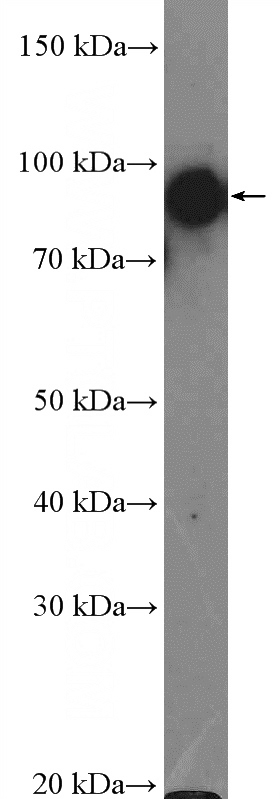
HeLa cells were subjected to SDS PAGE followed by western blot with Catalog No:111570(HSP90 Antibody) at dilution of 1:3000
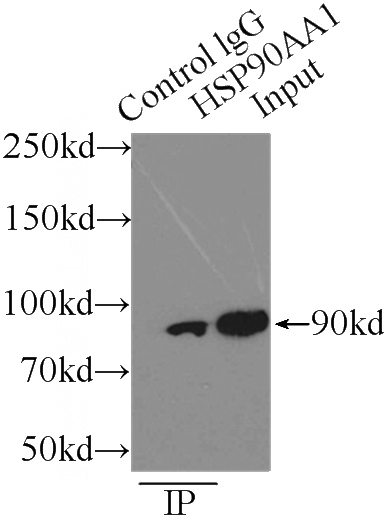
IP Result of anti-HSP90 (IP:Catalog No:111570, 3ug; Detection:Catalog No:111570 1:500) with K-562 cells lysate 2000ug.
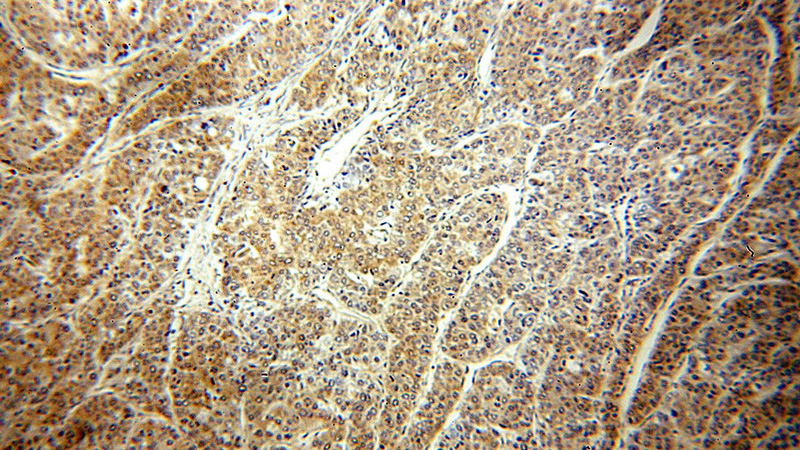
Immunohistochemical of paraffin-embedded human liver cancer using Catalog No:111570(HSP90 antibody) at dilution of 1:50 (under 10x lens)
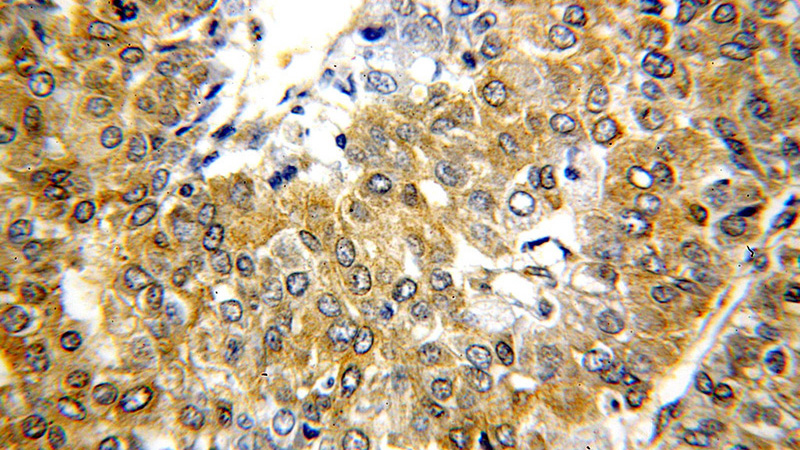
Immunohistochemical of paraffin-embedded human liver cancer using Catalog No:111570(HSP90 antibody) at dilution of 1:50 (under 40x lens)
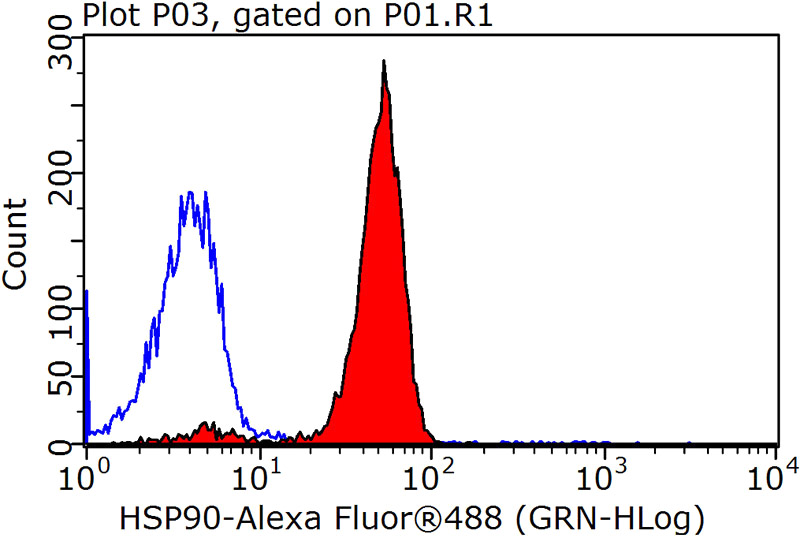
1X10^6 HeLa cells were stained with 0.2ug HSP90 antibody (Catalog No:111570, red) and control antibody (blue). Fixed with 90% MeOH blocked with 3% BSA (30 min). Alexa Fluor 488-congugated AffiniPure Goat Anti-Rabbit IgG(H+L) with dilution 1:1500.
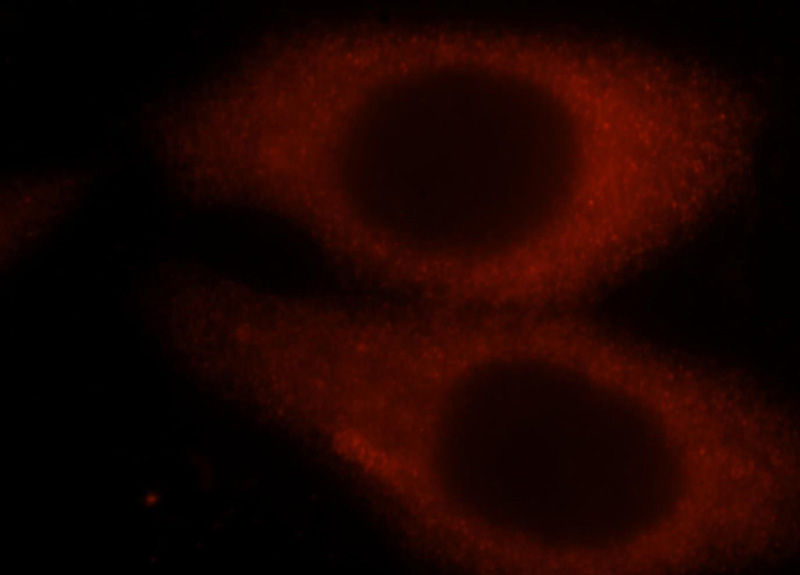
Immunofluorescent analysis of HepG2 cells, using HSP90AA1 antibody Catalog No:111570 at 1:25 dilution and Rhodamine-labeled goat anti-rabbit IgG (red).
-
Background
HSP90, encoded by HSP90AA1, is a constitutively and ubiquitously expressed molecular chaperone that is crucial for the stability and function of many proteins. HSP90 provides chaperoning activity for client proteins; many of them are members of oncogenic pathways, indicating its implication in tumor malignancy. HSP90 mainly resides in the cytosol, while it can also be released to the extracellular space. Secreted Hsp90 is a C-terminal truncated form. It has been reported that the level of plasma Hsp90 is positively correlated with tumor malignancy in clinical cancer patients, and can be a promising diagnostic marker for tumor malignancy in clinical application.
-
References
- Liu XY, Wei B, Shi HX, Shan YF, Wang C. Tom70 mediates activation of interferon regulatory factor 3 on mitochondria. Cell research. 20(9):994-1011. 2010.
- Ullmann Y, Klein Y, Savulescu D. Salivary monitoring related to major surgery. European journal of clinical investigation. 40(12):1074-80. 2010.
- Zhu XN, Chen LP, Bai Q. PP2A-AMPKα-HSF1 axis regulates the metal-inducible expression of HSPs and ROS clearance. Cellular signalling. 26(4):825-32. 2014.
- Chen RX, Song HY, Dong YY. Dynamic expression patterns of differential proteins during early invasion of hepatocellular carcinoma. PloS one. 9(3):e88543. 2014.
- Yang L, Wang Y, Zhang Q. Identification of Hsf1 as a novel androgen receptor-regulated gene in mouse Sertoli cells. Molecular reproduction and development. 81(6):514-23. 2014.
- Wei B, Cui Y, Huang Y. Tom70 mediates Sendai virus-induced apoptosis on mitochondria. Journal of virology. 89(7):3804-18. 2015.
- Li D, Xu T, Cao Y. A cytosolic heat shock protein 90 and cochaperone CDC37 complex is required for RIP3 activation during necroptosis. Proceedings of the National Academy of Sciences of the United States of America. 112(16):5017-22. 2015.
- Gritsyna YV, Abdusalamova ZR, Vikhlyantsev IM. Changes in gene expression and content of Hsp70 and Hsp90 in striated muscles of mice after 30-day space flight on the biosatellite Bion-M1. Doklady. Biochemistry and biophysics. 463(1):199-202. 2015.
Related Products / Services
Please note: All products are "FOR RESEARCH USE ONLY AND ARE NOT INTENDED FOR DIAGNOSTIC OR THERAPEUTIC USE"
